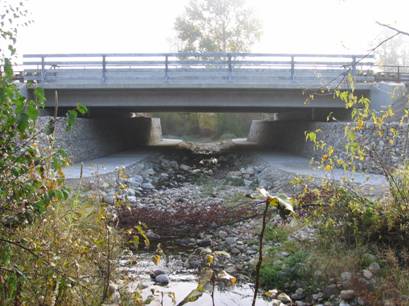
This wildlife crossing allows aquatic, amphibious or terrestrial life to safely cross the roadway. |
BOISE — Every day, Krista Muller drives her Idaho Department of Fish and Game truck along Highway 21 in the Boise foothills northeast of town, searching for roadkill.
As a technician for the Boise River Wildlife Management Area, she keeps inventory of the animals that die after getting hit by traffic on a 20-mile stretch of highway between Warm Spring Avenue and Robie Creek.
Nearly every day in the spring and fall, when deer and elk are migrating between low and high country, she'll come across a smear of blood and a crumpled carcass lying on the side of the road.
After all, this section of highway was considered the state's worst for vehicle collisions with wildlife, killing 150-200 mule deer and 5-10 elk each year.
But thanks to a newly constructed wildlife underpass, Muller says that she’s finding fewer dead animals. Along the three-mile section that funnels wildlife into the underpass, which was completed in October, 2011,only one deer has been hit by a car. In past years, Muller says, five or six animals would be hit along the same section.
For further proof that the underpass is working, Muller points to photos that show mule deer and elk, and the occasional fox, coyote, or mountain lion passing through the underpass. During the past spring, Muller watched as more and more animals crossed under Highway 21 from the lower reaches of the Boise River drainage into higher elevations for the summer.
They're starting to know where the underpass is and they're definitely using it. Animals smell each other. As soon as you have some animals using it, others will follow through,” Muller said.
Model for Other Crossings
Officials with the Idaho Transportation Department (ITD) say that the Highway 21 underpass could act as a model for similar projects around the state. ITD environmental planners Greg Vitley and Scott Rudel said that the underpass, which was primarily funded by a $1.1 million federal stimulus package, will improve migration routes for deer and elk.
Though some critics scoff at the price tag, arguing that a few dead deer and elk don't necessitate a million-dollar project, Vitley and Rudel say that calculations show that the underpass will eventually pay for itself.
They estimate that Highway 21 drivers incur about $483,000 in damage each year through a combination of insurance claims, deductibles, medical costs and disability leave, along with the resources spent in recovering road kill.
For the particular three-mile section serviced by the underpass, they estimate savings of $20,000-$40,000 annually.
“We've seen success on this already,” Vitley said. “Once we put more fencing up there, we think we will see a lot more success and we hope that the public will see the benefits of these kinds of structures.
“We're talking 600,000 to a million people living in the area. Considering the growing population center, and the fact that the wildlife management area is in critical habitat this problem is not going to go away,” Rudel said.
History
The idea for the underpass originated in August 1997 when local, state and federal agencies began meeting to consider ways of mitigating vehicle-wildlife collisions in Idaho.
They created a statewide database of wildlife-vehicle collisions, and determined that the Warm Springs Avenue-Highway 21 corridor was the highest priority in the state.
After the formation of the Boise River Wildlife Linkage Partnership – a coalition of government organizations and citizens — ITD began investigating potential areas for constructing wildlife passages along Highway 21. Using more than 30 years of data collected by Fish and Game, they mapped out migration routes and pinpointed areas of high deer fatalities.
In 2009, ITD applied for a grant through the American Recovery and Reinvestment Act and received about $1.1 million and they chose milepost 18.2, for the underpass based on an analysis that combined environmental and engineering concerns:
On the east side of the highway, several draws converge into the underpass from the ridges above, creating a natural funnel for wildlife migrating down from the Sawtooth Mountains. The hillsides in this area show terracing from the historical migrations of deer and elk through the corridor. The west side of the underpass leads to Lucky Peak Reservoir, Mores Creek and summer pastures.
The topography allowed engineers to construct the underpass without cutting off traffic to Highway 21. Essentially, crews were able to tunnel under the highway, retrofitting the underpass rather than constructing an entirely new structure. This helped keep costs relatively low.
Looking to the Future
The first phase of construction, completed by ITD using the federal stimulus money resulted in a 30-foot wide, 15-foot high underpass, along with 6,600 feet of 8-foot high fence that parallels the highway to the west in order to funnel wildlife toward the underpass.
The project remains incomplete, however, and future phases of construction include extending the fences along the east side of the highway. The Boise River Wildlife Linkage Partnership is still trying to secure funding to continue with the fence construction.
Muller says the Boise River Wildlife Linkage Partnership is committed to developing other vehicle underpasses along Highway 21.
“Now that we've got it and can see that it works, I think people are going to say let's build it into future plans,” she said.
| |
.jpg)
This south Florida fencing is similar to the barrier used along the Highway 21 outside of Boise. |